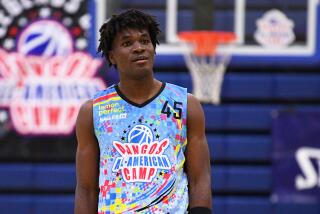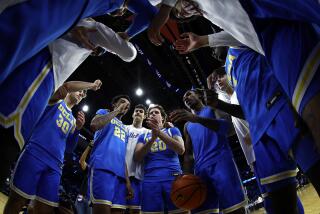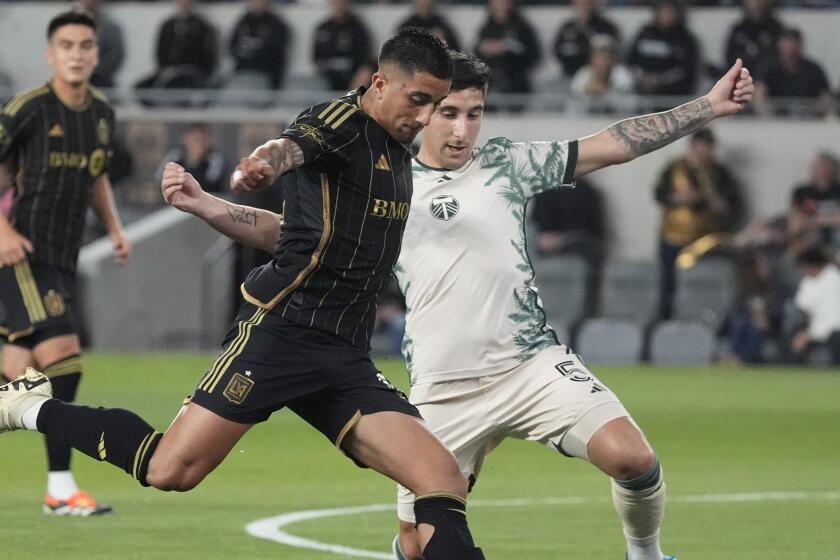Summer is no vacation for club basketball
Reporting from Las Vegas — His jersey soaked, his shoulders glistening with sweat, Ishmael Wainwright managed a weary smile as he posed for celebratory pictures with teammates.
The Kansas City 76ers had just won the 17-under invitational division of the prestigious Las Vegas Fab 48 tournament, capping a stretch of three games in 11 hours Monday and eight games in four days.
“I just want to go home and go to sleep,” said Wainwright, a junior forward from Raytown, Mo., who is coveted by UCLA and other top college programs.
Alas, home wasn’t on the agenda. Wainwright’s team was headed to Anaheim for the Best of Summer Tournament starting Wednesday, the next in a seemingly endless string of events that test even the steely resolve of resilient teenagers.
Club players can participate in as many as five games in a day and 80 in a season that stretches from late March through October. That’s more than twice as many games as they play during the high school season. Last year, Wainwright played 12 games a weekend for two teams in different age groups.
Critics contend that the workload has some troublesome consequences: injuries, a breakdown in fundamentals and wear-and-tear issues that can linger for years.
“What I see as the biggest fallout from kids playing so many games is you’re seeing kids more and more showing up to college with things like tendinitis already going on in their body,” UCLA Coach Ben Howland said. “They’re already suffering from doing too much too soon where it breaks down their body. That’s a worry.”
Shabazz Muhammad, widely considered the top high school senior in the country, played through most of the recent Adidas Super 64 tournament with a strained ligament in his foot. When he sustained a severely sprained ankle Tuesday morning, Howland and his assistants left town because they were told Muhammad wouldn’t play in the championship game later in the day.
Muhammad not only played but gutted out 22 points before his team, San Diego-based Dream Vision, faded down the stretch in a 93-78 loss to Texas Assault.
I just wanted to try and help my team win,” Muhammad said.
What would it have taken for him not to play?
“Probably a broken foot,” he said. “And I would still try to go out there.”
In NCAA-certified club events this month, players are not supposed to participate in more than five games in any two-day period. Ron Montoya, director of the Super 64, hailed the rule, recalling tournaments six years ago when participants would play 11 games over the final two days.
“You’d be playing every hour,” Montoya said.
Not that there aren’t a few still trying. Some skirt the NCAA rules, Montoya said, by playing for multiple teams in various tournaments, making their schedules almost impossible to track.
The goal would be to get as much court time as possible to assure maximum exposure in front of the college coaches who come to evaluate prospects.
“The kids get sucked into way too many games that they think they need to play in the summer,” Westchester High Coach Ed Azzam said. “Our kids get seen, whether it’s in practice with college coaches coming by or the tournaments we play in over the year.”
Azzam would probably like the way Ohio handles the club circuit during August, when players are forbidden to participate in any events inside or outside the state.
“Kids get to be kids,” said Satch Sullinger, the father of Ohio State sophomore Jared Sullinger and a former longtime high school and club coach.
By the time school starts in September, some high school coaches say, their players are burned out. And many of those who aren’t need to be weaned of the poor fundamentals they developed during the club season.
“They come back with tremendous bad habits,” said Bellflower St. John Bosco Coach Derrick Taylor. “AAU basketball is not real basketball. They don’t play very much defense, guys concede layups and it lacks the structure of good basketball.
“Some AAU coaches teach good basketball. Most don’t.”
Compounding the overuse issue are teams that use a rotation of only seven or eight players, forcing their starters to play 28 minutes or more in a 32-minute game.
Muhammad said pushing through game after game required some give-and-take with the other players on his team.
“Sometimes you’re just going to be really tired where you have to look at your teammates and have them do stuff too,” Muhammad said. “Sometimes you have to step up and they’re going to need you.”
Wainwright, who possesses the chiseled 6-foot-6, 220-pound physique of a mature college player, has a special prescription for the grueling schedule: He tries to get as much rest as possible and eat healthy foods during the club season “so my body will be feeling good.”
“My body is fit to play this many games,” Wainwright said. “Now it’s just a mental game.”
More to Read
Get our high school sports newsletter
Prep Rally is devoted to the SoCal high school sports experience, bringing you scores, stories and a behind-the-scenes look at what makes prep sports so popular.
You may occasionally receive promotional content from the Los Angeles Times.







